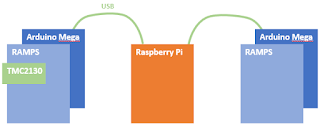Electronics #3: Setting up the first RAMPS with Klipper

This is part #3 in a list of postings on the electronics of my CEVO. The full list can be found here . The topic of this list is initial very simple setup of a RAMPS/Arduino with Klipper. Note that further steps comes in later parts and that the photographs shows my test setup, not the final wiring. When talking about the RAMPS board, we usually means the RAMPS 1.4 , which is a quite simple board that is designed to piggyback on an Arduino Mega . Originally is was designed as an 12V board, but most boards can be used more or less directly with 24V following one of the many guides on doing this (see for example here and here ). The original design was made for manual soldering, and most RAMPS boards are variations of varying quality of this, I am however going for the BIGTREETECH Ramps 1.6 , which is a Chinese surface mount design - see a good review here , also read the enlightening comments below the video. I have two of these, and to my unqualified eyes they look to ha...


